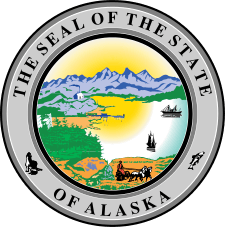Matanuska-Susitna Valley

Matanuska-Susitna Valley (/mætəˈnuːskə suːˈsɪtnə/) (known locally as the Mat-Su or The Valley) is an area in Southcentral Alaska south of the Alaska Range about 35 miles (56 km) north of Anchorage, Alaska.[1] It is known for the world record sized cabbages and other vegetables displayed annually in Palmer at the Alaska State Fair.[2] It includes the valleys of the Matanuska, Knik, and Susitna Rivers.[3] 11,000 of Mat-Su Valley residents commute to Anchorage for work.[4] It is the fastest growing region in Alaska and includes the towns of Palmer, Wasilla, Big Lake, Houston, Willow and Talkeetna.[1]
The valleys are shaped by three mountain ranges: the Alaska Range, the Talkeetna Mountains and the Chugach Mountains.[3] The Matanuska-Susitna Valley was carved by glaciers[5] leaving thousands of lakes.[6] The Mat-Su rivers and lakes are home to the spawning grounds of chinook, coho, sockeye, pink, and chum salmon.[7] The area is home to 31 state parks and campgrounds.[8]
The 23,000-square-mile (60,000 km2) Matanuska-Susitna Borough[9] (the Alaskan equivalent of a county)[3] governs the Mat-Su Valley. According to the 2010 Census, the borough's population is 88,995, a 50% increase since 2000.[10]
The Mat-Su Valley was originally inhabited by Athabaskan people and was explored by Russians in 1818.[11] In 1893 the Alaska Commercial Company was built at Knik and gold miners came into the area in 1898. Wasilla was originally inhabited by the Dena'ina Indians. The city began when the Alaska Railroad was constructed in 1917. In 1898, Knik was settled by trappers and miners. Talkeetna began in the 1916, with the construction of the Alaska Railroad.
In 1935, as part of the New Deal 203 families from the Midwest travelled to Alaska and started the Matanuska Valley Colony.[12] Families were specifically chosen from the states of Minnesota, Wisconsin and Michigan, due to their similarly cold winter climates.[13] The area now known as Palmer was originally inhabited by Athabaskan Indians. Wasilla was originally inhabited by the Dena'ina Indians. The city began when the Alaska Railroad was constructed in 1917. In 1898, Knik was settled by trappers and miners. Talkeetna began in the 1890s, with the construction of a trading station and later the Alaska Railroad. Today, Talkeetna serves as the starting point for mountaineers who climb Denali.[11]
The 1939 Slattery Report on Alaskan development identified the region as one of the areas where new settlements would be established through Jewish immigration. This plan was never implemented.
The region is also home to the Matanuska-Susitna College[14] and the Mat-Su Valley Frontiersman newspaper.[15]
See also
- Anchorage metropolitan area
- Goose Bay Airport (Alaska)
- Matanuska Formation
- Matanuska-Susitna Borough, Alaska
References
- 1 2 "About the Mat-Su: the Matanuska-Susitna Valley". 2011. Retrieved 23 April 2011.
- ↑ Johnson, Greg (16 August 2010). "Green Envy". Frontiersman. Retrieved 23 April 2011.
- 1 2 3 "Matanuska-Susitna Valley". Alaska Trekker. Retrieved 23 April 2011.
- ↑ "Kinik Arm Bridge". 2008. Retrieved 23 April 2011.
- ↑ "Palmer/Wasilla Day Trips & Tours". AlaskaTours. 2011. Retrieved 23 April 2011.
- ↑ "Mat-Su Outdoor Activities and Adventures". 2011. Retrieved 23 April 2011.
- ↑ "Conserving Salmon Habitat in the Mat-Su Basin" (PDF). Mat-Su Basin Salmon Habitat Partnership. 2008. Retrieved 23 April 2011.
- ↑ "Find a Park, Campgrounds, Alaska State Parks". Alaska Department of Natural Resources Division of Parks and Outdoor Recreation. 16 December 2010. Retrieved 23 April 2011.
- ↑ "Visitors: Yahoo Mat-Su! Alaska Vacations for Visitors and Alaska Residents". Retrieved 23 April 2011.
- ↑ "U.S. Census Bureau Delivers Alaska's 2010 Census Population Totals, Including First Look at Race and Hispanic Origin Data for Legislative Redistricting". United States 2010 Census. Retrieved 23 April 2011.
- 1 2 "Past and Present". 2011. Retrieved 23 April 2011.
- ↑ "Thriving at 75: Mat-Su marks Colony anniversary". Anchorage Daily News. 4 June 2010. Retrieved 23 April 2011.
- ↑ "The Matanuska Valley Colony". Retrieved 16 October 2014.
- ↑ "About Mat-Su College". Mat-Su College, Alaska. 2011. Retrieved 23 April 2011.
- ↑ "About Us: Frontiersman". Mat-Su Valley Frontiersman Newspaper. 2011. Retrieved 23 April 2011.
External links
Coordinates: 61°23′N 150°15′W / 61.383°N 150.250°W
